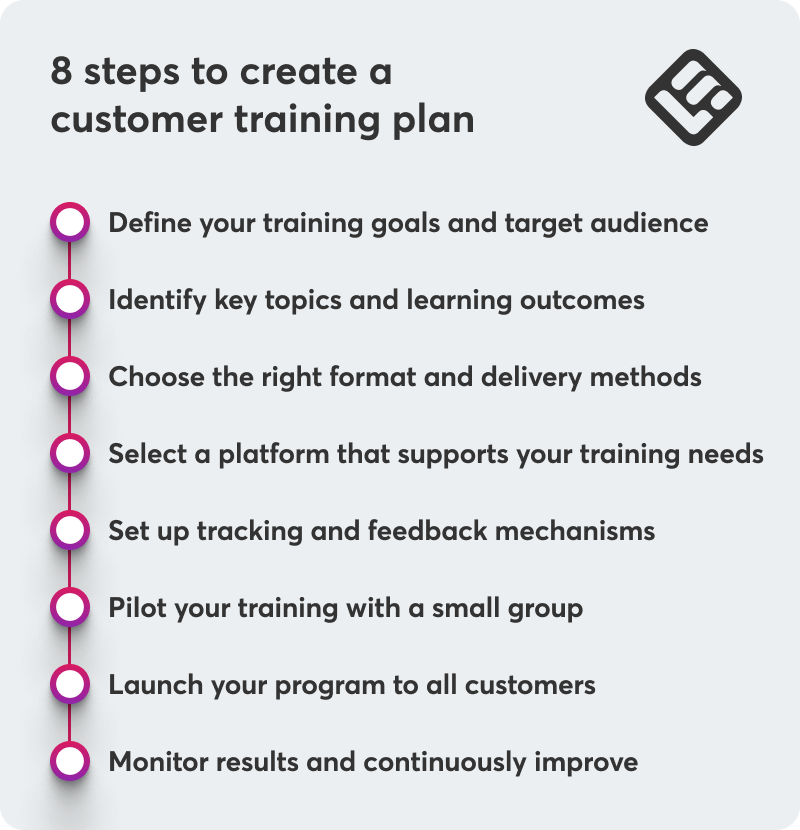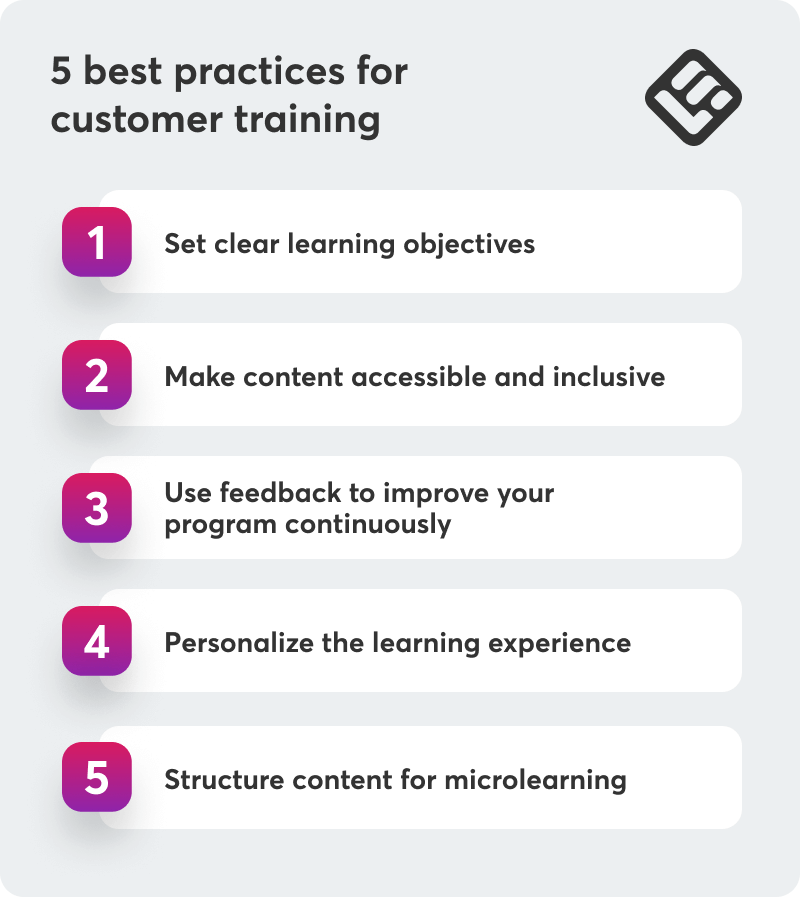Table of Contents
Complex products? Check.
Customers with short attention spans? Check.
Pressure to prove ROI? Got that too.
We’ve all faced this while trying to improve customer training.
Many leaders I talk to say they struggle with keeping users engaged and managing support costs. So what do they want? Client training that equates to real and measurable change.
According to Gallup, fully engaged customers represent a 23% premium [1] in share of wallet, profitability, revenue, and relationship growth over the average customer. This marks the critical role training plays in long-term customer value beyond LMS metrics.
In this post, I’ll share practical tips that have helped me and countless others to make it through these exact challenges. I’ll help you create effective customer training that lets you retain customers, generate product success, and drive growth.
What is customer training?
Customer training is, or rather unites, all the education opportunities you use to teach customers how to use your product/service so they’ll achieve their specific objectives. This includes delivering educational content (eg learning resources, courses, webinars, tutorials) and even having one-on-one calls with customers to offer personalized support.
Generally, customer training is used to help customers uncover features, easily navigate the product, and troubleshoot fundamental problems. There are even more benefits to this.
The benefits of client training
Some of the main benefits of customer training include the following:
💡Keep learning: 11 benefits of customer training that drive business growth
What should be included in customer training programs?
One thing I always start with is keeping customer training programs simple, engaging, and actionable. To achieve this, I focus on offering a structured journey that can easily take customers from newbies to using advanced features as soon as possible.
Next is everything else I include in customer training programs to support customers:
Optionally, consider community rooms or peer learning options for engagement and certification or completion badges to motivate and reward learners.
Examples of client training programs
For more inspiration, you can check out examples of real-life success stories, but the following three are musts.
Customer onboarding
Onboarding should always be a part of your training. This can look like a series of tutorials, an initial checklist to set up the tool, or live customer training to ensure customers are comfortable with fundamental features.
Product education
Product education is every type of training that happens after onboarding and is meant to help customers advance. Training materials here may include tutorials, interactive courses, or webinars for users to learn more about advanced functionality and best practices.
Certification programs
Certifications give customers accreditation when completing a training course. They inspire learners, drive participation, and also create trust and transparency for your product.
Building a customer training strategy
I always go into building a customer training strategy with thorough forethought, so much so that I can literally see what customers need and want. When you try to get to know them first, you’ll better understand their goals so you can prepare useful learning experiences they’ll enjoy.
After all, this is what will help you make a clear list of what you need to focus on in your customer training plan.
When starting, Gianluca Ferruggia, General Manager at DesignRush prepares you for a common pitfall:
“The most commonly forgotten piece of a successful customer training strategy is ongoing engagement after the initial launch. Many companies put the effort into a complete onboarding experience or tutorials to onboard customers, but then assume that their job is done. The reality is, customers need continual reinforcement, in-context onboarding support and easily accessible resources to be able to adopt your product and realize value.”
So let’s move on to how to create your first customer training plan for a stellar customer experience.
How to create a customer training plan
When creating a customer training plan, you need to take it step by step so that your training efforts are focused with both customer needs in mind as well as company goals.

1. Define your training goals and target audience
Start by setting clear training goals and identifying the target audience. Include everyone, looking at their challenges from the outside and leaving bias towards what you think they need.
Not sure? Ask them or go through your regular support tickets to understand what’s unclear or if there are underutilized features within your platform that need a bit of extra attention.
2. Identify key topics and desired outcomes for learning
From here, make a note of the key topics and learning objectives users have. That’s what you’ll have to add to your onboarding and subsequent learning materials.
3. Choose the right format and delivery methods
Selecting the right format and delivery methods also matters here. Start simple with help page articles and gradually add video tutorials, live webinars, or interactive modules to cater to the various types of learners.
4. Select a platform that supports your customer training needs
Choosing the right customer training tool to support the training experience is another essential step. What apps will support training materials creation? How will you manage users? Do you need any integrations with third-party systems?
5. Set up tracking and feedback mechanisms
To make sure the training sticks, I’d always add tracking and feedback systems to measure engagement and produce insights. This kind of regular feedback helps me improve content and provide timely learner support.
6. Pilot your training with a small group
Things don’t have to be perfect from the start. Try the program out with a test group before taking it public to notice any missing content or problems.
7. Launch your program to all customers and monitor results
When everything’s ready, it’s time to roll it out to everyone and make continual adjustments based on real data and feedback.
How to promote your program for training clients
As a marketer, I inevitably see plenty of opportunities to actually promote a customer training program among our users. When you don’t announce it to your customers, they won’t know about it.
Good promotion depends on who your customers are and how they prefer to consume training content, though.
Let me walk you through a couple of best practices for marketing your customer training program, but remember, you need to adapt these to your own target customers.
How to measure customer training success
Start tracking the success of your customer training program by measuring the KPIs that reflect learning engagement and business success. These KPIs can be course completion rates, learner engagement, customer satisfaction scores, retention rates, and lower support ticket numbers.
Apart from engagement and satisfaction, calculating the return on investment (ROI) of your training programs will further help you showcase tangible business value. ROI measurement means associating training activities with business results such as sales growth, customer lifetime value, decreased cost of acquisition, and decreased churn.
It can definitely be difficult to pinpoint the direct influence of training. But by monitoring financial KPIs over time, you’ll actually be able to justify your customer support resources investment.
Customer training best practices
To be transparent, it always pays off to be unique when picking your go-to customer training methods. Still, there are a couple of things customers expect. I’m talking about standard formats, clarity, and the following best practices.

Set clear learning objectives
Always begin by identifying learning objectives that describe what customers will be able to do after going through the training. When you have too many goals for a single training material, you risk confusing users and they’ll only end up reaching out to your support team again.
Make content accessible and inclusive
Another priority is making the content accessible and inclusive. I always try to develop online learning resources that suit different learning styles and abilities so everyone gets an equal opportunity to use the knowledge within the app.
Use feedback to improve your program continuously
I also really appreciate having rolling feedback from learners and being able to iterate on the program, keep it current, and make it better.
Sure, in most cases, people will hesitate to share feedback as they’re often caught up with their own work. In this case, though, simply go through your support tickets to get a good feel of what you’re not clear enough about in training.
Personalize the learning experience
Feedback is also great for personalized training. 81% of customers prefer companies that offer a personalized experience. The more we can customize the learning experience (based on role or skills), the more we can get customers to engage and win.
And, this is backed up by Veronika Karubian, the Founder & CEO at BioPup:
“To save time and cut costs, businesses often produce generic training content that doesn’t address the specific use cases of individual customers. Thinking of every customer as the same, and making assumptions that focus on what you want to teach rather than what they need to learn, are missed opportunities in building trust and long-term loyalty.”
Structure content for microlearning
You don’t need a complete academy from the start. Start by designing microlearning content, breaking down complex subjects into manageable, bite-sized units that accommodate people’s busy lives and can help with customer retention.
And I’ve got just the right customer training tools to help you with this all.
Best tools for a successful customer education academy
Building a robust customer education program requires using the right tools to create, deliver, and manage content effectively.
Below are some popular types of virtual training platforms that can help you develop and enhance your customer education strategy.
1. Online course platform
Customer education platforms, which are designed specifically for customer training or Learning Management Systems (LMS) that serve multiple educational purposes, are excellent solutions to deliver, track, and manage educational courses and training programs.
Pros
- Customization capabilities: LMSs offer a range of features and integrations that can be tailored to meet the specific needs of your organization, from course creation to user management.
- Scalability: LMSs are suitable for businesses of all sizes and can accommodate unlimited users and content, allowing you to start small and scale up as needed. They also support several use cases and allow you to build different learning environments for different audiences.
- Centralized content and user management: Using an LMS, you can streamline your customer education efforts and easily manage content and users through automations and bulk actions.
- Reporting and analytics: All LMS platforms provide insights into learner progress and course effectiveness, enabling data-driven improvements.
Cons
- Complex setup: Implementing an LMS can be complex and may require technical expertise and several weeks to be completed.
- Learning curve: Some LMSs are rather hard to figure out since they have so many features and capabilities.
- Cost: Some systems can be expensive, especially for small businesses or those with limited budgets.
LearnWorlds stands out as a top solution for customer education. It serves diverse use cases and is consistently ranked high by users due to its ease of use, wealth of features, and advanced customization and scalability, all this at a fair price that’s not restrictive to SMBs.
2. Content creation tools
Content creation tools are software applications used to develop multimedia learning materials, such as videos, tutorials, presentations, and interactive courses. They enable educators and trainers to design engaging and professional-quality content for various learning purposes.
Pros
- Engaging content: Enables the creation of professional-quality tutorials, videos, and interactive courses, enhancing the learning experience.
- Ease of use: Many content creation tools are designed to be user-friendly, requiring minimal technical skills to produce high-quality materials.
- Versatility: Supports a wide range of content types, from videos to infographics and presentations.
Cons
- Not an all-in-one solution: Using content creation tools doesn’t solve the problem of centralizing and streamlining your training efforts.
Again, this is why going with an all-in-one customer training platform like LearnWorlds is the most stress-free option that saves you from the trouble of juggling between tools.
3. Webinar and live training platforms
Webinar and live training platforms are online services that facilitate real-time virtual training sessions, workshops, and presentations. They offer features like screen sharing, audience interaction, and session recording to enhance live learning experiences.
Pros
- Real-time interaction: Web conferencing platforms support live training sessions with features like screen sharing and audience engagement tools, such as polls and Q&A.
- Wide reach: Enables reaching a large audience simultaneously, making it ideal for global training sessions.
- Recording features: Sessions can be recorded for later use and turned into a valuable resource for learners.
Cons
- Technical issues: Live sessions can be prone to technical difficulties, such as connectivity issues or audio problems.
- Engagement challenges: Keeping participants engaged in a virtual environment can be challenging.
4. Community and collaboration platforms
Community and collaboration platforms are digital spaces that allow users to engage in discussions, share knowledge, and collaborate on projects. They foster interaction among users, offering learning through peer-to-peer support and knowledge sharing.
Pros
- Enhanced learning: Peer-to-peer learning and knowledge sharing are extremely effective ways to learn effortlessly in an informal environment.
- Increased engagement: Providing a platform for customers to interact with your brand and each other enhances engagement and brand loyalty.
- Customer support: Offers a space for users to seek help and share experiences, reducing the load on customer support teams.
Cons
- Moderation required: Active management and moderation are necessary to ensure a positive and productive community environment.
- Clunky and not agile: Community platforms can take a while to update and tend to be hard to maintain when it comes to new content and sunsetting older content.
5. Course marketplace platforms
Course marketplace platforms, like LinkedIn Learning, are online platforms that offer a wide range of courses from various providers. They provide learners with access to diverse educational content, allowing for personal and professional development across multiple subjects.
Pros
- Wide reach: Course marketplaces are very popular, which means they will be viewed by thousands of potential customers.
- No need for marketing: Since course marketplaces have so many visitors, you don’t have to do anything to market your course to get it to a wider audience.
Cons
- Hard to stand out: On the flip side, the popularity of online course marketplaces also means that it might be hard for your course to stand out.
What to look for in software for customer training
If there’s one thing you need to prioritize when choosing customer training software, it’s making sure it’ll help you accomplish your goals and make learning easy and fun.
Here’s what I mean by this.
Look for software that provides a friendly UI/UX to create an easy learning experience.
Pick a tool that will let you create and upload different types of content (eg videos, quizzes, PDFs) to make the experience rich on top of that.
Strong analytics and reporting are also important to monitor learner progress, activity, and know where you need to improve.
Integration options are another part of the package to make your own team’s life easier with faster workflows.
You’ll also want to make sure your customer training platform is mobile responsive or, even better, has a native app.
💡Keep learning: How to make an app for online courses
LearnWorlds: The ideal customer training platform
A good customer training strategy starts with the right tool. LearnWorlds has all the features you need to build an engaging customer education academy.
With intuitive content authoring and a superlative website builder, to multiple schools, custom branding, branded mobile apps, and advanced AI capabilities, LearnWorlds provides a smooth learning experience and makes sure your customers stay fully engaged so they’ll succeed in using your tool.
Discover LearnWorlds with a 30-day free trial today.
Sources
[1] Use a customer-centric strategy to build engagement and loyalty – Gallup
Alexandra Cote
Alexandra Cote is a SaaS growth marketer and online instructor who's worked with dozens of brands in the MarTech, HR tech, and productivity space. She's also a strong supporter of staying happy at work and choosing a healthy career path.



